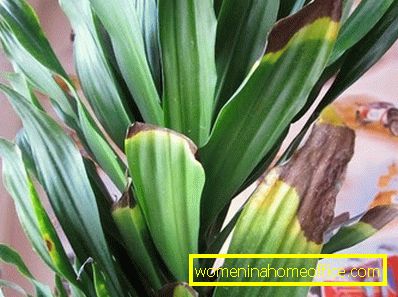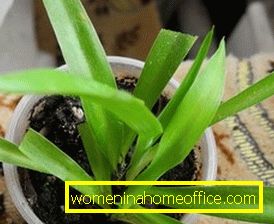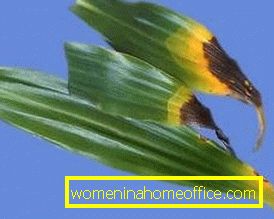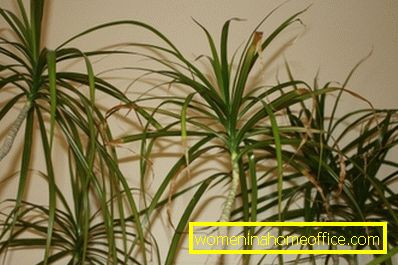Dracaena
What kind of plants have settled in city apartments - and palm trees have long become full-fledged residents of standard apartments, and among such green "pets" a special place in the hearts of florists has taken dracaena. Wonderful exotic beauty is considered unpretentious, but still with her there may be questions about why dracaena leaves turn yellow, or dry their tips, how to get rid of a strange bloom on their surface, and why the green suddenly lost its intensity.
Care for dragon season at home

To prevent the main problems with dratsenoy, you need to correctly approach the issue of caring for her. This will not completely protect you from the sudden illness of the plant, but will allow you to have confidence that the cause will not be your accidental mistake, but an external factor - for example, a pest. The palm tree, which has created all the conditions for a comfortable life, can last up to 15 years in an apartment, while growing to 70-80 cm and even blooming (this is characteristic of the fluffy dragon-tree).
Professionals focus on watering dracenes, because it is important to follow a special schedule for each season. In the summer, the bush is watered daily or even 2 times a day if the clod of soil at the roots dries out (typical of rooms with windows to the south). In cool rooms watering is quite likely 1 time in the 2nd day. The lack of moisture in the summer - one of the reasons that the dracaena dry tips of the leaves. What to do? Do not let the ground dry out more than 3 cm deep. In this case, it is necessary to additionally irrigate the leaves with water: this can be done 2-3 times a day. Water must be at room temperature, in any case not icy. It is also advisable to filter it or simply defend it: the quality of the water is similar to what you use for personal use.
Also, the intensity and frequency of irrigation draceni will be influenced by the volume of the pot in which the bush sits, the density of the substrate chosen for it (clay soil retains moisture longer than sandy loam). If it turned out that you overdo it with the amount of liquid during watering, loosen the top layer (2-3 cm) of the earth - this will not allow the roots to over-wet and rot.

In winter, the dracaena is watered less frequently, since a period of rest comes for it, and the air temperature in the room decreases. The optimal frequency of irrigation in the cold season is 1 time in 3-4 days, but it may persist even 1 time in the 2nd day, if the pot with palm tree is located near the heater, or the air temperature is maintained at a high temperature. Spraying the leaves is not done, and the abundance of watering also decreases. Best of all, the schedule for this period should be plotted according to the drying rate of the earthen coma in the pot.
The next important point is the lighting. Like other exotic flowers, dracaena loves sunshine and grows poorly in winter, with its deficiency, but with direct sunlight for a palm tree is unacceptable. It is located close enough to the window, but in the case of its exit to the south or southeast, at the peak of solar activity, the dragon tree is tamed. Often, excessive illumination becomes the key to the solution of the question of why the tips of the leaves of the draceni dry. However, not only this can lead to a deterioration of the plant. And, at the same time, the bush may need additional lighting with fluorescent lamps in winter. In addition, it is important to know that varieties and species of dracaena with dark green leaves are much less in need of good lighting than those that have motley foliage.
Not the last place in the general algorithm of care for the dragon tree at home is taken by transplants: it is desirable for the plant to change its “place of residence” as it matures, since the root system is very powerful and it quickly outgrows the current pot. Therefore, transplants are carried out up to the moment when the dracaena is 4-5 years old, when its growth slows down. An adult bush with a height of 70 cm requires a pot with a diameter of 30-35 cm, not less. When dracaena stops growing, transplants are performed 1 time in 1-2 years to change the land in which it sits. This is due to the need to add nutrients to all layers. But despite the strong root system, the palm should be transplanted carefully, trying not to hurt the roots - any damage to them can cause a deterioration in the condition of the bush.
The main problems with dragon stage and their solutions


The most common question asked by flower growers who decide to grow this plant at home is why the dracaena has dry leaf tips and what to do in such a situation? It is the problems with foliage that are most relevant in the case of palm tree care.
As mentioned earlier, in most cases the drying up of the tips of the leaves or their entire area is caused by too high air temperature in the room where the dracaena lives, as well as a lack of watering and burning sun rays falling directly on the shrub. The solution, of course, is nowhere easier: normalize the watering schedule for dracaenas, move the pot in partial shade, ventilate the room more often or turn off the heating to keep the temperature at a lower level (19-20 degrees).
Also, one should not discount the drying and yellowing of leaves of dracaena due to drafts, as well as disruption of the chemical balance of the substrate. Often it is necessary to change the mixture, which feeds the bush, add humus or sand, depending on how loose or clay soil. If nothing helped, you may have to transplant a palm tree into a new pot, where the soil is picked up again from the drainage stones to the bottom to the sand on the surface.
But what if all these requirements are met, and the tips of the dracaena leaves are also dry, and the plant can soon become completely lifeless?

- First, we must not forget that plants, like people, are characterized by a physiological aging process, and in the case of dracaena, it is externally manifested in the desiccation of the lower leaves. With him there is no need to fight, on the contrary, the dead foliage needs to be removed so that it does not prevent the appearance of a new one. If the shrunken area has a small area, you can simply cut it, eliminating 3-5 mm of green leaf.
- Secondly, in addition to the moments of the incompetence of the grower or his accidental misstep, there are also infectious factors - diseases obtained through the interaction of a plant with a pest. However, the leaves in this situation do not dry: more often they appear bloom, sticky film, foamy white formations or yellowing, which can be as a bloom, signaling the appearance of a tick, and sunburn.
- You can cope with pests by treating the leaves with soapy water or insecticides, but with other diseases it is sometimes more difficult. In particular, the affected bacteriosis (oily film from high humidity) dracaena treatment does not respond, and the bush must be disposed of. With a deficit of moisture and humidity, on the contrary, brown spots appear on the leaves, and such a plant needs to be treated with fungicides. The same is true for spots that blacken over time, which is characteristic of a fungal disease.
Now you know why the ends of the dracaena dry up and what to do in such a situation: follow the temperature regime, the irrigation schedule and how the light falls on the plant. Compliance with these rules of care for dracaena greatly increases the chances of its healthy appearance. And before you panic, think about it - maybe your flower just had time to get rid of the lower foliage?